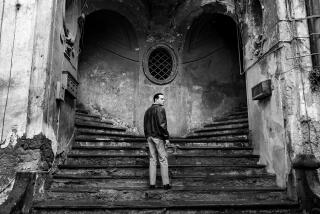Commentary
- Share via
WASHINGTON — Television looks better than ever. Honest! Program content may not have improved an iota, but form is thriving. A visual medium is becoming dynamically visual at last. If there still is little worth watching on TV, there at least is more worth seeing.
It used to be that scant care was lavished on how something looked on TV, unless it was a plate of fluffy mashed potatoes in a commercial or an anchorperson’s equally fluffy hairdo. Television programs tended to arrive on the screen brandishing the same styleless style, factory-made anonymity marked by flat lighting, humdrum art direction and no sense of composition.
But for a few notable exceptions, you couldn’t tell one show from the other. Now you can.
Something happened to change television. Or some things. One was “Miami Vice,” perhaps the first prime-time show in history to be pitched to viewers largely on the way it looked. Another was MTV, the cable network, which displays its high-fashion music videos in a showcase full of witty, gleaming animated graphics, a nonstop kinetic carnival.
Inspired by such influences--and by the awesome, sometimes mind-blowing visual prowess of the top commercial makers--program producers and network executives have started paying more heed to the way their programs look. Suddenly, television is pretty. And getting prettier.
And voila, presto, hocus-focus, there you have it: Video Nouveau, television of the ‘80s, arguably as empty as ever but wrapped in a colorful new coat of chic, deluxe gloss.
“Miami Vice” may have spearheaded the trend, but now other producers have grabbed the baton and run with it. The latest and most obvious, perhaps inescapable, example is ABC’s “Max Headroom,” a wizardly mishmash of electronic and cinematic effects.
“Max” has visual density. There may not be a lot more to it than what meets the eye (and the second episode was, unfortunately, a drastic letdown from the first), but what does meet the eye has detail and complexity beyond that of most mortal television.
From Hollywood, Peter Wagg, the producer of the show, says “a tremendous amount” of work goes into the way Max looks. “We want to maintain a depth of production value that keeps people coming back week after week,” Wagg says.
Do viewers care how shows look? There’s evidence they are becoming increasingly aware of it--more style-conscious, more sophisticated. They’re used to seeing big-budget movies, with elaborate production values, on cable TV, and so their standards are getting tougher.
Also, the TV picture itself is improving. When properly installed, cable can deliver superb quality. The first generation of digital TV’s, now in stores, boast dramatically improved pictures. Viewers are likely to be more interested in how something looks when they can see it clearly.
Attention to detail has not often been a preoccupation of TV producers. Just getting the darned thing done on time took precedence. Wagg says a new, “non-television attitude” is surfacing in Hollywood that involves upgrading TV shows to movie levels.
Certainly series like “L.A. Law,” “Crime Story,” “Amazing Stories,” and “Moonlighting”--as well as “Miami Vice”--look as rich as, or better than, many theatrical films. But if Video Nouveau has a flagship show, it’s, of all things, “Pee-wee’s Playhouse” on CBS Saturday mornings. Pee-wee Herman presides over perhaps the most design-intensive half-hour on TV.
Ostensibly a kiddie show, “Pee-wee’s Playhouse” is also watched by millions of adults. Not for nothing does CBS run promos for Dan Rather’s newscast right there in the middle of Pee-wee Herman’s funcast.
Good looks ain’t cheap. “Max Headroom,” though it has a relatively small cast and no big stars, comes in at about $1.4 million an hour. Wagg, who will not confirm any figures, says those who labor over “Max” expend extra time and energy to keep up its appearance, to such an extent that “casualties are falling all over the battlefield at the moment” from burn-out.
If “Max Headroom” succeeds, it will be good for television, just as the success of “Miami Vice” and “Moonlighting” and MTV have been. As production design and art direction are upgraded, so the more substantive aspects of program-making are likely to improve.
An audience that starts taking visual excellence for granted is less likely to settle for the crummy and the shoddy however they manifest themselves on the tube. One of the great things about television is its capacity for rejuvenation. Who knows but that its second childhood might even surpass its first.
More to Read
The complete guide to home viewing
Get Screen Gab for everything about the TV shows and streaming movies everyone’s talking about.
You may occasionally receive promotional content from the Los Angeles Times.






